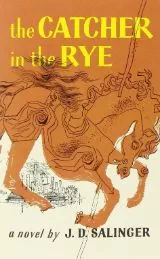Brave New World by Aldous H...
Written by Aldous Huxley in 1931 and publishe...
By Susan Giles1475

1

J.D. Salinger is an American writer, best known for his novel “The Catcher in the Rye,” which was published in 1951. Shortly after its release, Salinger became a household name. His admirers were mostly college students at the time.
He devoted himself to writing after attending college, and his writing style took an interesting turn after he returned from World War II. One of his popular pieces that were heavily influenced by the time he spent in the military is a short story called “For Esmé—with Love and Squalor”.
Salinger wrote several short stories that were published in renowned magazines, such as The New Yorker, and later collected in books. One of his most famous collections is called “Nine Stories,” which includes “A Perfect Day for Bananafish,” an anecdote that tells the story of a suicidal veteran.
Now, let’s talk about the book that won critical acclaim and major recognition from critics and readers all over the world. The protagonist of the story is a rebellious and angsty teenager called Holden. Holden despises the world and everyone around him because he believes that they are phony and pretentious.
At first glance, he seems just like another bitter adolescent who cannot take the heaviness of life and would rather resent the world around him that partake in it. He blabbers a lot and his rants last for pages, which is why some readers may find him self-absorbed and even a little annoying, but if you think about it, we were all kind of like him at the age of sixteen. The thing is, you either relate to Holden and thank God that Salinger understands you, or despise him for being that immature and whiny.
Holden isn’t all that bad, though; he is an avid reader who likes to educate himself despite his failure at school, which he justifies by saying that he didn’t care enough about the topics taught in class.
His old teacher tried to reach out to him, but the boy didn’t seem to listen because his mind was already set. You see, Holden wanted to help other kids, but didn’t want to be helped himself, so he preferred to struggle rather than listen to advice.
The problem with people like him is that they carry the weight of the world on their shoulders and look at their issues from a narrow perspective only. Holden didn’t know how to see the bigger picture and often got too caught up on minor inconveniences.
He kept struggling on his own until he collapsed on the psychiatrist’s chair and had a nervous breakdown. The book is an accurate depiction of the often sad and depressing life of teenagers who tend to feel bitter and angry growing up. This illustration of teenage angst holds true to this day; you will find a lot of people of Holden’s age suffering from the same destructive thoughts and mental anguish.
Holden spent a lot of time searching for the truth and the lost innocence of childhood. When his sister Phoebe asked him about his future dreams and aspirations, he said that he wanted to protect children from adulthood and help them preserve their pure nature.
In other words, he longed to be the catcher in the rye. Having been influenced by a poem called “Comin’ Thro’ the Rye” by Robert Burns, he envisioned childhood as a field of rye where everyone should stay forever, just like Peter Pan in Neverland.
He wanted to be the person to stop innocent children from falling off the cliff, which is a metaphor for adulthood with all its greed, hatred, and inauthenticity. This is where the title of the book came from.
At first glance, Holden seems like just another superficial protagonist with an immature perspective of life. Some fans loved the book when they were sixteen and are still in love with it twenty years later, while others detest it completely.
However, if you approach it with an open mind, you’ll see that The Catcher in the Rye can actually help you reconnect with your past rebellious self. Even if that phase in your life was full of disappointments, this book will make you reminisce about the long-lost innocence of childhood.
Updated 4 years ago